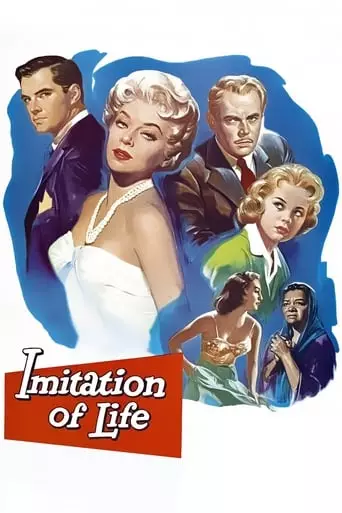
Imitation of Life (1959) Watch Online Free
In 1940s New York, a white widow who dreams of being on Broadway has a chance encounter with a black single mother, who becomes her maid.
Imitation of Life is a 1959 American melodrama directed by Douglas Sirk, based on Fannie Hurst’s 1933 novel. The film centers on two widowed mothers—Lora Meredith (Lana Turner), a white aspiring actress, and Annie Johnson (Juanita Moore), an African American housekeeper. They form a close friendship and business partnership, raising their daughters together in a shared household. Lora’s daughter, Susie (Sandra Dee), and Annie’s daughter, Sarah Jane (Susan Kohner), grow up under this arrangement. As they mature, Sarah Jane, who has light skin, grapples with her biracial identity and desires to pass as white, leading to tension with her mother. The narrative explores themes of race, identity, and the complexities of motherhood, culminating in a poignant and emotionally charged conclusion.
Douglas Sirk’s direction in Imitation of Life is renowned for its lush visual style and emotional depth. The film employs melodramatic conventions to tackle serious social issues, particularly racial identity and the desire for social acceptance. Sirk’s use of color and composition enhances the narrative, reflecting the inner turmoil of the characters. The performances are compelling, with Juanita Moore and Susan Kohner delivering standout portrayals that convey the pain and resilience of their characters. The film’s treatment of race and identity was ahead of its time, offering a nuanced exploration of these themes within the context of 1950s America.
The film delves into the complexities of racial identity, particularly through Sarah Jane’s struggle to pass as white. Her internal conflict and the societal pressures she faces highlight the painful realities of racial discrimination and the desire for acceptance in a racially divided society.
Both Lora and Annie embody the theme of motherhood, each making significant sacrifices for their daughters. Lora’s pursuit of a career often leads her to neglect her daughter, while Annie’s unwavering support for Sarah Jane underscores the depth of maternal love and the personal costs of such devotion.
The film explores the aspirations of its characters to transcend their social classes. Lora’s ambition to achieve fame and wealth reflects the American Dream, while Annie’s desire for a better life for her daughter illustrates the pursuit of upward mobility despite systemic barriers.
The relationship between Lora and Annie evolves from friendship to a complex partnership, highlighting themes of trust, betrayal, and the complexities of human relationships. Annie’s eventual decision to leave the household she helped build with Lora underscores the fragility of their bond.
Upon its release, Imitation of Life was a commercial success, becoming Universal-International’s top-grossing film of 1959. Critically, it received mixed reviews, with some critics dismissing it as a soap opera. However, over time, the film has been re-evaluated and is now considered a masterpiece of Sirk’s American career. It has been praised for its bold treatment of racial and social issues, which were rarely addressed in mainstream cinema at the time. The film’s legacy endures, influencing discussions on race, identity, and the American Dream in film studies and popular culture.
The film offers a poignant and thought-provoking narrative that delves into complex social issues, particularly racial identity and the pursuit of acceptance. Its exploration of these themes through the lives of its characters provides a rich and engaging viewing experience.
The cast delivers exceptional performances, with Juanita Moore and Susan Kohner offering portrayals that are both nuanced and emotionally resonant. Their ability to convey the depth of their characters’ struggles adds significant emotional weight to the film.
Douglas Sirk’s direction is marked by his signature visual style, utilizing color and composition to enhance the emotional impact of the story. The film’s cinematography is both lush and expressive, contributing to its status as a visual masterpiece.
Imitation of Life addresses issues of race and identity with a depth and sensitivity that was ahead of its time. Its candid portrayal of these themes offers valuable insights into the societal dynamics of 1950s America.
The film’s exploration of motherhood, sacrifice, and personal identity resonates on a deeply emotional level. Its ability to evoke empathy and reflection makes it a powerful cinematic experience.
Viewing Imitation of Life provides a window into the social and cultural attitudes of the 1950s, particularly regarding race and class. This historical perspective enriches the understanding of the film’s themes and their relevance to contemporary discussions.
Over the years, the film has been re-evaluated and is now considered a classic, praised for its bold storytelling and direction. Its enduring legacy in film history makes it a must-watch for cinema enthusiasts.
After watching Imitation of Life, you will likely experience a profound emotional response to its exploration of complex social issues and the human condition. The film’s candid portrayal of racial identity and the pursuit of acceptance may evoke feelings of empathy and introspection. The performances, particularly by Juanita Moore and Susan Kohner, are likely to leave a lasting impression, highlighting the depth and resilience of their characters. The film’s visual style and direction may also evoke admiration for its artistic achievements. Overall, you can expect to be moved and challenged by the film’s unflinching examination of societal norms and personal identity.
